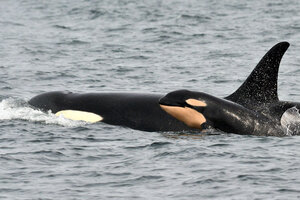Orca baby boom: Enough to save the endangered whales?
Four newborn orcas have been spotted off the coast of Washington and British Columbia, including one apparently midwifed by other orcas.

In this photo provided by the Pacific Whale Watch Association, a newborn orca whale swims alongside an adult whale, believed to be the mother, in the Salish Sea waters off Galiano Island, B.C., March 15. The endangered population of killer whales that spend time in Washington state waters is experiencing a baby boom with the fourth baby orca documented this winter. The newborn was spotted Monday by whale-watching crews and a naturalist in the waters of British Columbia, according to the Pacific Whale Watch Association, which represents 29 whale-watching operators in Washington and British Columbia. The orca was swimming with other members of the J-pod, one of three families of orcas that are protected in Washington and Canada.
Jeanne Hyde/Maya's Legacy Whale Watching/AP/File
Orcas in the Pacific Northwest are experiencing a baby boom – and not a moment too soon, say experts.
The population off the coast of Washington and British Columbia hit a 40-year low in December, when a pregnant orca died in the Georgia Strait, near Vancouver. Area experts feared it was the beginning of the end for the killer whale population there, reported The Toronto Star.
"Not only did we not have the baby coming that we needed, but we also lost a breeding-age female," said Michael Harris, executive director of the Pacific Whale Watch Association. "We thought we were on an irreversible slide to extinction."
In an area famous for its orca pods, the population had dropped from a high of 98 in the mid-90s to just 78 whales in the summer of 2014. The death of the pregnant whale dropped the population to a low of 77.
Following the death of the orca mother in December, local experts believe the pod delivered the next baby together, to ensure its successful arrival. Ken Balcomb of the Center for Whale Research and his colleagues noted bite marks on the newborn’s fin, indicating other whales may have served as midwives, pulling the baby from the womb. The researchers then observed the calf in the care of its grandmother for the first few days, while its mother recovered.
"They made very sure that the birth was going to go well this time," said Mr. Harris. "Literally the baby was just pulled out by other members of the pod."
He added, "That started the baby boom.”
By the end of the spring, four calves had been born, bringing the total population total to 81. About 35 to 45 percent of newborn orcas don't make it past their first year, according to NOAA. If these babies survive, they will be the first successful newborns in the Puget Sound population in about two and a half years.
Eric Ward, who tracks the whale population for NOAA Fisheries, told the Star that the pods are still a long way from the 120 whales necessary to remove them from the endangered list.
"There’s reasons to be optimistic for this population, and there’s reasons to be concerned," said Dr. Ward.
He attributes their initial decline in part to depleted populations of prey, including the pods’ favored Chinook salmon. He also says contaminants from fish that spawn near urban areas may have been a factor.
In 2014, the Chinook salmon population spiked, and that may have turned things around, combined with a demographic shift with more orca females of reproductive age.
This baby boom "will continue as long as there’s available prey," said Ward.
Still uncertain is the effect of warmer ocean temperatures on the Pacific fish stock, who generally prefer colder waters. This past winter, tides shifted and warmer sea temps were recorded.
"We don’t know the implications this giant blob of warm water will have on marine life and the killer whales," Ward said.

